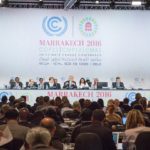Search Results
More than 35,000 people from around the world gathered in Quito in October to celebrate the adoption of a New Urban Agenda, and an estimated 20,000 people convened in Marrakech two weeks ago for COP22. The events and dialogue that ...

Can nature help cities address the twin problems of air that is too dirty or too hot? Based on a new report released by The Nature Conservancy – in collaboration with C40 Cities Climate Leadership Group – the answer appears ...

Does urban living threaten our sanity and happiness? Popular culture is rife with stories which suggest that living in a city increases loneliness and unhappiness, and some scientific studies indicate that urbanization increases mental illness and depression. Are these claims credible? How can communities ...

Today is Transport Day at COP22, which will highlight the important contribution transport can make to reduce greenhouse gas emissions. Over the last two years, the Lima-Paris Action Agenda (LPAA), as part of United Nations Framework Convention on Climate Change ...

What comes next for U.S. cities, now that the 2016 Presidential Election has come to a close? As polls closed on Tuesday, this question quickly came to the forefront for urban planners and city-dwellers, alike. In recent history, cities have been ...

What do you think of when you hear the word “slum”? For many, the word brings to mind poverty, violence and squalor; slums, or informal settlements, are overwhelmingly associated with the negative. This is particularly true in Rio de Janeiro, ...

One-third of the world’s energy-related emissions come from buildings. So perhaps it’s no surprise that more than 80 national climate plans submitted ahead of COP21 in Paris included commitments to improve building efficiency. A year later, the discussion continues with Human Settlements Day today at COP22 in ...

Bogotá, Colombia was recently named the least safe transit system for women, largely due to an epidemic of sexual assault (defined here as any type of unwanted sexual touching). According to a survey, conducted in Colombia and Bolivia as part ...

Cities and countries around the world are adopting building energy codes as tools to reduce energy consumption. Mexico City recently joined this wave, when, in June, the city updated its building regulations to include energy efficiency for the first time. ...

By 2050, nearly 70 percent of the world’s population will reside in cities, increasing the size of the world’s urban population by more than two-thirds. Cities will need to focus on building the right things to ensure this growth happens sustainably—so how ...

Two weeks ago, 30,000 people gathered in Quito, Ecuador, for Habitat III, the once-every-20-years UN conference on housing and sustainable urban development. At the conference, 167 country representatives adopted a non-binding but influential vision for cities of the future known as the ...

Habitat III in Quito was the largest UN meeting to date, with more than 36,000 people from 167 countries, thousands of organizations and institutions, hundreds of meetings and side events and the adoption of the New Urban Agenda (NUA). Habitat ...

Have you ever been intrigued by the artistic design of a metro station? Have you stopped to watch a street dancer perform on a metro platform? A metro station can be more than a place where you impatiently wait for ...

Looking for an opportunity to catalyze sustainable, people-centered urban mobility? The Lee Schipper Memorial Scholarship wants to help you transform ideas into reality. The Schipper family and EMBARQ, the sustainable urban mobility initiative of World Resources Institute’s WRI Ross Center ...

By 2030, the United States will demolish 82 billion square feet of existing building space to create new and modern structures. While some new buildings may be equipped with energy saving technologies and materials, the construction process itself consumes a lot ...

Page 54 of 228« First...1020...535455...6070...Last »
























